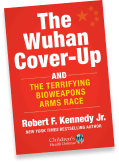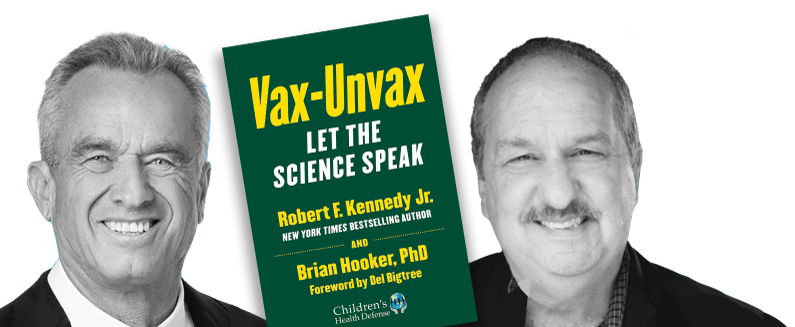NIH in Early 2022 Abruptly Stopped Responding to People Injured by COVID Shots
Documents obtained by Children’s Health Defense via a Freedom of Information Act lawsuit reveal officials at the National Institutes of Health corresponded with people injured by the COVID-19 vaccines throughout 2021, even launching a study only to pull the plug on it before finishing and reporting on it.
Miss a day, miss a lot. Subscribe to The Defender's Top News of the Day. It's free.
The National Institutes of Health (NIH) corresponded with people injured by the COVID-19 vaccines throughout 2021 and initially acknowledged their injuries — before abruptly ceasing communication with them in early 2022, according to documents obtained by Children’s Health Defense (CHD).
The documents, released Dec. 21, 2023, and Jan. 21, 2024, relate to correspondence between NIH researchers and people who contacted the agency regarding adverse events related to the COVID-19 vaccine.
CHD requested the documents via a Freedom of Information Act (FOIA) request filed in November 2022, and sued the NIH on April 12, 2023, to obtain them after the NIH failed to respond to the FOIA request.
The NIH filed a motion to dismiss the lawsuit, but in July 2023, withdrew its motion and agreed to release the documents — but only after NIH officials on two occasions claimed the agency had no knowledge of “adverse vaccination reaction reports.”
Those claims are contradicted by documents included in the initial releases, which show that NIH received vaccine injury reports and, in some instances, offered medical advice or even recommended specialists to those individuals.
In October 2023, the NIH agreed to produce up to 7,500 pages of documents at a rate of 300 pages per month. The agency said it could not make the documents available at a faster rate.
The first two sets of documents are heavily redacted. However, they reveal that the NIH Institutional Review Board had approval to formally launch a study on COVID-19 vaccine injuries, but the agency slow-walked the investigation throughout 2021.
By early 2022, the NIH ceased communicating with the vaccine-injured individuals it had been in contact with.
Reacting to the documents, Kim Mack Rosenberg, CHD’s general counsel, told The Defender, “We are carefully analyzing the documents to learn more about NIH’s study.”
Rosenberg said CHD “has been working hard to push for government transparency, which is the underpinning of our FOIA requests and litigation.”
She added:
“Even when receiving documents, slow response times and heavy redactions remain an issue. We understand that protected health information relating to individuals should not be shared and are subject to redaction, but other redactions may be subject to challenge.”
Brianne Dressen, who was injured by the AstraZeneca COVID-19 vaccine and later founded React19, a nonprofit that advocates for vaccine-injured individuals, contacted the NIH in 2021 about her injuries and the NIH study.
Dressen told The Defender, “The slow release of documents is what we are also seeing with other FOIA releases. They were far quicker at the start of the pandemic, but as things are now unraveling, these releases are taking longer and longer for the agencies to process,” she said.
Dressen, who sued the Biden administration over her vaccine injuries, said the new documents disprove NIH claims that it was unaware of a connection between the COVID-19 vaccines and vaccine injuries.
“The NIH’s comments about this study in mainstream media have all danced around the ‘causal link.’ They won’t publicly say there is a connection, but these FOIA documents say something very different,” she said.
Communications with vaccine-injured ‘faded’
According to CHD’s lawsuit, NIH researchers in early 2021, “began to hear from individuals who were experiencing severe, lasting health problems after COVID-19 injection, including neurological, cardiovascular, muscular, and other disorders.”
“The NIH researchers sought to learn more, even bringing some affected people to NIH headquarters for testing, and sometimes treatment,” the lawsuit stated.
Those efforts resulted in at least one publicly available paper, “Neuropathic symptoms with SARS-CoV-2 vaccination,” a preprint published May 2022 in medRxiv.
The paper examined 23 patients who reported new neuropathic symptoms within a month of COVID-19 vaccination. The authors found a “variety of neuropathic symptoms may manifest after SARS-CoV-2 vaccinations and in some patients might be an immune-mediated process.”
The study helped lead CHD to file its FOIA request, on Nov. 10, 2022. But while the NIH acknowledged receipt of the request on Nov. 18, 2022, it denied expedited review citing “a lack of compelling need.”
The NIH denied awareness of any vaccine injury reports in its possession and told CHD that “adverse vaccination reaction reports are filed with the FDA [U.S. Food and Drug Administration], not the NIH,” referring the request to the FDA FOIA office.
A Jan. 20, 2022, article in Science contradicted those denials. The article referenced “people who had experienced serious, long-lasting health problems after a COVID-19 vaccine, regardless of the manufacturer.”
By January 2021, according to Science, NIH “began to hear about such reports and sought to learn more.” But by late 2021, “NIH’s communications with patients faded.”
NIH promised to survey injuries but never followed through
The documents obtained by CHD confirmed this timeline — and the NIH’s knowledge of COVID-19 vaccine injury reports, despite extensive redactions marked with code “b6,” pertaining to “personal privacy interests,” including medical information.
Sheryl Ruettgers, a professional counselor associate from Oregon, was injured after COVID-19 vaccination and contacted the NIH in 2021. She told The Defender the documents released so far “are so heavily redacted, they are incomprehensible,” adding, “I do not believe this is by accident.”
“It speaks to their efforts to cover up their knowledge of the severity of COVID vaccine injuries and their early and firsthand knowledge that so many were suffering from neurological reactions,” Ruettgers said.
Dr. Danice Hertz, a retired gastroenterologist who contacted the NIH in 2021 about her injury, said, “There’s a lot of duplication” in the documents released so far and “many blank pages.”
Still, the documents provide insights into the NIH’s communications with vaccine-injured individuals in 2021. Examples of emails to the NIH include:
- April 2, 2021 (page 103, December 2023 documents): email to Farinaz Safavi, M.D., Ph.D., of the NIH Division of Neuroimmunology and Neurovirology and Amanda Wiebold of the NIH/National Institute of Neurological Disorders and Stroke (NINDS): “I was given your email and asked to send you a message regarding the reaction I have had to the Moderna covid 19 vaccine.”
- March 14, 2021 (pages 145-146, December 2023 documents): listed “severe symptoms following the 1st dose of the Pfizer vaccine,” including dysesthesia, cold and burning sensations, and numbness.
- Sept. 22, 2021 (pages 56-57, December 2023 documents): email to Dr. Avindra Nath, clinical director at NIH/NINDS, referred to a “horrific ‘vax fog’ that is not going away,” with the patient adding, “I would have been better off not getting the vaccine.”
- Oct. 12, 2021 (pages 63-64, January 2024 documents): email referred to a “pretty bad flare up” involving a “painful” skin rash, fever, weakness, night sweats, worsening joint and muscle pain and random bruises. The patient said these symptoms were “extremely disruptive,” adding, “I am very desperate.”
The documents also reveal the NIH acknowledged communications from vaccine-injured people who reached out:
- March 15, 2021 (page 145, December 2023 documents): email from Safavi stated, “We started an effort to evaluate post covid vaccine reactions.”
- March 2, 2021 (page 237, January 2024 documents): email from Nath told a vaccine-injured person, “We are following several patients with neurological symptoms from the COVID vaccines,” adding, “Our hope to try and identify if there is some kind of molecular mimicry between vaccine and the antigens in the nervous system.”
- A March 6, 2021 (pages 105-106, December 2023 documents): email from Safavi to a vaccine-injured individual with the subject line “Re: Covid vaccine reaction” asked the patient to send “a summary of your disease course, work ups and treatments,” as well as medical images, “to be reviewed by our team.”
- March 5, 2021 (page 107, December 2023 documents): email from Safavi to a vaccine-injured patient stated, “We can certainly meet through televisit and go over your post vaccine issues.”
- March 18, 2021 (page 166 of the December 2023 documents): email from Safavi said “we are trying to characterize COVID vaccine side effects and potentially propose the pathogenesis.”
- Feb. 8, 2021 (page 113, January 2024 documents): email from Wiebold to a patient requested the results of the patient’s spinal tap and said that NIH’s account, not the patient’s insurance, would be billed.
- May 5, 2021 (page 15, January 2024 documents): email from Wiebold instructed a patient how to send NIH a blood sample.
The documents also show (page 190, January 2024 documents) that Nath scheduled a July 30, 2021, Zoom meeting with a vaccine-injured individual, “to discuss COVID vaccine allergic reaction” and that Safavi, in a March 29, 2021, email (page 239, January 2024 documents) told a patient a Microsoft Teams link for a televisit would be sent.
NIH staff also referred to an online survey being developed. A Sept. 23, 2021, email (page 41, December 2023 documents) from Angelique Gavin, NIH/NINDS clinical operations manager, states, “We are currently developing an online survey system to collect stories about people’s complications after receiving COVID vaccines.”
This online survey was “never developed,” Ruettgers said.
On some occasions, NIH personnel also dispensed advice to people who reached out about vaccine injuries, including recommendations of specialists they could contact.
For example, in an Oct. 6, 2021, email to a patient (page 171, December 2023 documents), Nath wrote, “The best person to address this issue [studies of brain injuries] would be Dr. Gary Gibbons … Director of NHLBI [National Heart, Lung, and Blood Institute],” noting that “his institute received most of the funds for COVID research.”
And April 2021 emails (pages 194 and 195, January 2024 documents) from Nath provide therapy advice to patients, including suggesting to a patient that they be investigated for POTS (postural orthostatic tachycardia syndrome).
At least two emails in the December 2023 documents reference a waiting list established by NIH for new patients to enroll in its study.
“Nowhere in any of these emails does the NIH say this is ‘alleged’ injury, or that this isn’t from the vaccine, nor do they explore any other possible cause other than the specific cases where COVID itself is reported,” Dressen said.
Dressen added:
“This isn’t some random disease they can’t possibly find the cause [of] or any answers. They were bringing people in, helping them in-house and remotely, talking through their care with their providers, using that information to build their understanding of the illness, and were providing treatment recommendations.”
Yet according to Dressen, while the NIH was aware of this, the general public was told, “the vaccines couldn’t possibly cause these injuries.”
“The general public still has no idea that any of this happened,” Dressen said. “Had the NIH done the right thing and talked with the medical community about what they were researching in depth, where would all of these injured Americans be today?”
‘Who pulled the plug?’
A 2020 patient consent form listing Nath as the principal investigator for the NIH’s study (page 129 of the December 2023 documents) references a “Natural History Study of Inflammatory and Infectious Diseases of the Nervous System” and shows that the NIH’s Institutional Review Board approved the study on April 9, 2020.
Yet, a Nov. 4, 2021, email (page 95, December 2023 documents) from Gavin states, “The study has not yet been approved by our review board.”
In an August 13, 2021, email (page 192, December 2023 documents) a vaccine-injured individual asked Gavin, “Is it ok for me to share this publicly? ‘Dr Nath’s team is planning on studying people who have had extended neurological or other symptoms after getting a COVID vaccine’” after Gavin stated on Aug. 10 that “the study has not yet been approved.”
People who were injured by the vaccines and in contact with the NIH expressed frustration with the protracted study approval and launch process.
For instance, in a Jan. 11, 2022, email (page 50, December 2023 documents), a vaccine-injured individual asked, “Why nothing is being done to help all of us who were injured by the Pfizer” and Moderna COVID-19 shots? Another, from the same date (page 52), asks for “the contact email of whoever is responsible for not providing care for us and not researching what is happening to us.”
“When these emails are put into a timeline, you can see the research team being honest and straightforward for the first half of 2021, then everything changes,” Dressen said. “They start getting more vague in their responses but still work with people, just not as straightforward and openly as they did before.”
By sometime in January 2022, the study appears to have stopped. “Who pulled the plug?” Dressen asked. “Was it [Dr. Anthony] Fauci?”
NIH ‘reported people healed when, in fact, we were not’
“I believe that Nath and Safavi may have had good intentions to help find answers, but that seems to quickly have been squashed and, I believe, they were silenced by Fauci and [former NIH director] Francis Collins and perhaps the FDA,” Ruettgers said. “Contact with the NIH came to a screeching halt.”
Ruettgers said she received the Moderna COVID-19 vaccine on Jan. 14, 2021, and soon experienced adverse reactions. By June 2021, she said her symptoms were so severe that she “was barely able to function.” Ruettgers was diagnosed with immune-mediated small fiber neuropathy, dysautonomia and reactivated Epstein-Barr virus.
“I had to take anti-seizure medication to sleep, and I was terrified I was going to die. I was healthy prior to my vaccine,” she said, adding that she still experiences symptoms such as neuropathy, hypoesthesia, paresthesia, slow gut motility, blurred vision, inner ear burning, extreme fatigue, fleeting dizziness and foot cramps.
Ruettgers said she unsuccessfully tried to contact FDA and Centers for Disease Control and Prevention (CDC) officials and submitted several reports to the Vaccine Adverse Event Reporting System (VAERS) and the CDC’s V-safe app, but except for one telephone call, the CDC did not follow up with her.
Ruettgers said she later reached out to the NIH in March 2021, speaking with Safavi, with whom she “agreed to participate” in the agency’s study.
“I sent Safavi all my tests, brain and thoracic images and lab results (skin biopsy results) indicating positive for small fiber neuropathy. Initially, Safavi asked if I was willing to fly out to the NIH and I said yes. When I revisited the topic, she told me they were no longer bringing people to the NIH,” Ruettgers said.
“As a consolation, she offered to discuss treatment with my neurologist, which she did in July 2021,” Ruettgers added. “Once she had all my records, she never communicated with me again. We all know now that the study was bogus and they lied about the results … The NIH essentially reported people healed when, in fact, we were not.”
Hertz described a similar experience. She suffered serious adverse events after she received her first (and only) dose of the Pfizer-BioNTech COVID-19 vaccine on Dec. 23, 2020. She was diagnosed with mast cell activation syndrome (or mast cell disorder), a condition in which a patient experiences repeated episodes of anaphylaxis symptoms.
“I’m still suffering from all the same symptoms, but they’re just milder,” Hertz said.
Hertz said she filed several VAERS reports and reached out to the FDA, CDC and Pfizer “multiple times.” Yet, “there was no response, no interest in our fight, no help.”
When Hertz learned about the NIH study, she contacted Nath, who initially was “very sympathetic” and said NIH was “hearing from many other people with similar injuries.”
But Hertz said that by Jule 2021, Nath’s “tone changed,” becoming “almost antagonistic,” before she was “cut off” entirely. Hertz said she learned “from other similarly injured people that the same thing had happened to them.”
NIH ‘hung us all out to dry’
Dressen said she hopes “some internal communications come through” in future document releases “that [will] help us understand what went on behind the scenes when their strategy changed, why they didn’t report these injuries, why they didn’t expand the study to include the sheer number of people reaching out to them.”
Ruettgers said she wouldn’t “be surprised to discover that the knowledge and cover-up of neurological reactions went much higher up the government food chain.”
She added:
“The slow pace at which the documents are being released leads to suspicion that they are processing the documents with an extremely keen method of redaction to protect themselves from, at the least, accusations of medical malpractice, and at the worst, medical fraud and corruption, leading to a Congressional investigation.”
Dressen said that “when the NIH says something different privately than they do publicly or officially, they are not being honest or transparent.” She added:
“The NIH gathered the information, then hung us all out to dry … This goes beyond a ‘simple misunderstanding.’ Something went very wrong at the NIH, and it was at the expense of the American people.”
Hertz said she would like federal agencies to acknowledge people’s injuries. “It’s just really time for them to stop ignoring what has happened.”
Sign up for free news and updates from Children’s Health Defense. CHD focuses on legal strategies to defend the health of our children and obtain justice for those injured. We can't do it without your support.






